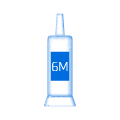01 / 03
HYLO NIGHT®
by Ursapharm
IntroductionMedication Usage
Protects the Tear Film during Sleep
HYLO NIGHT®
HYLO NIGHT®
Sincerely recommend to people concerned the following issues
- Eyestrain
- Dry eyes
- Burning sensation
- Foreign body sensation
HYLO NIGHT® Ingredient Information
- Vitamin A (Retinol palmitate) 250l.U.
- Preservatives free
- White vaseline
- Phosphate free
- Wool fat
What is Vitamin A (Retinol Palmitate)?
Vitamin A is a well-known essential nutrient present naturally in healthy eyes and tear film. It plays a crucial role in regulating the proliferation and differentiation of corneal epithelial cells, protecting the conjunctiva and goblet cells. It is suitable for eye conditions such as dry eye, superior limbic keratoconjunctivitis, or conjunctivitis.
Vitamin A plays an important role in the generation of the mucin layer, which is the innermost lubricating layer of the tear film and vital for a healthy tear film. Deficiency of vitamin A can lead to loss of the mucin layer and atrophy of goblet cells.

Vitamin A eye preparations:
Can protect the eyes from free radicals, toxins, allergens, and inflammation. Research has shown that the topical use of Vitamin A (Retinol Palmitate) can be effective in treating dry eye syndrome.
Image 1:The structure of normal tear film.
Image 2:The tear film insufficiency. The vitamin A in HYLO NIGHT® eye ointment can improve goblet cell density and mucus production.
The figure above shows the vitamin A in Hylo-Night has been proven to effectively improve tear film break-up time (TBUT), indicating its potential efficacy in addressing issues such as dry eyes.
Hylo-Night: Uninterrupted Eye Protection

Contains the oily substance Vitamin A (Retinol Palmitate)
Which is a physiological component of the tear film. Vitamin A (Retinyl Palmitate) imparts a unique softness to the eye ointment, forming an even and stable lubricating protective film on the ocular surface that is less likely to be washed away.

Protects the ocular surface and forms a stable layer together with the tear film
Maintaining the health of the corneal and conjunctival epithelial cells.Designed specifically for ocular use, Hylo-Night is ideal for maintaining eye lubrication and comfort during the nighttime when artificial tears may not provide the desired effect.

Not contain any medicinal ingredients
And serves as a smooth and comfortable ointment base that quickly dissolves to prevent dryness and discomfort.

Preservatives Free
Preservatives can disrupt the lipid layer of the tear film, making the eyes more prone to dryness and discomfort.
HYLO® EYE CARE SERISE
Friendly Reminder: Before using this product, please consult a specialist or professional healthcare provider if you are an infant, child, or pregnant woman.





















